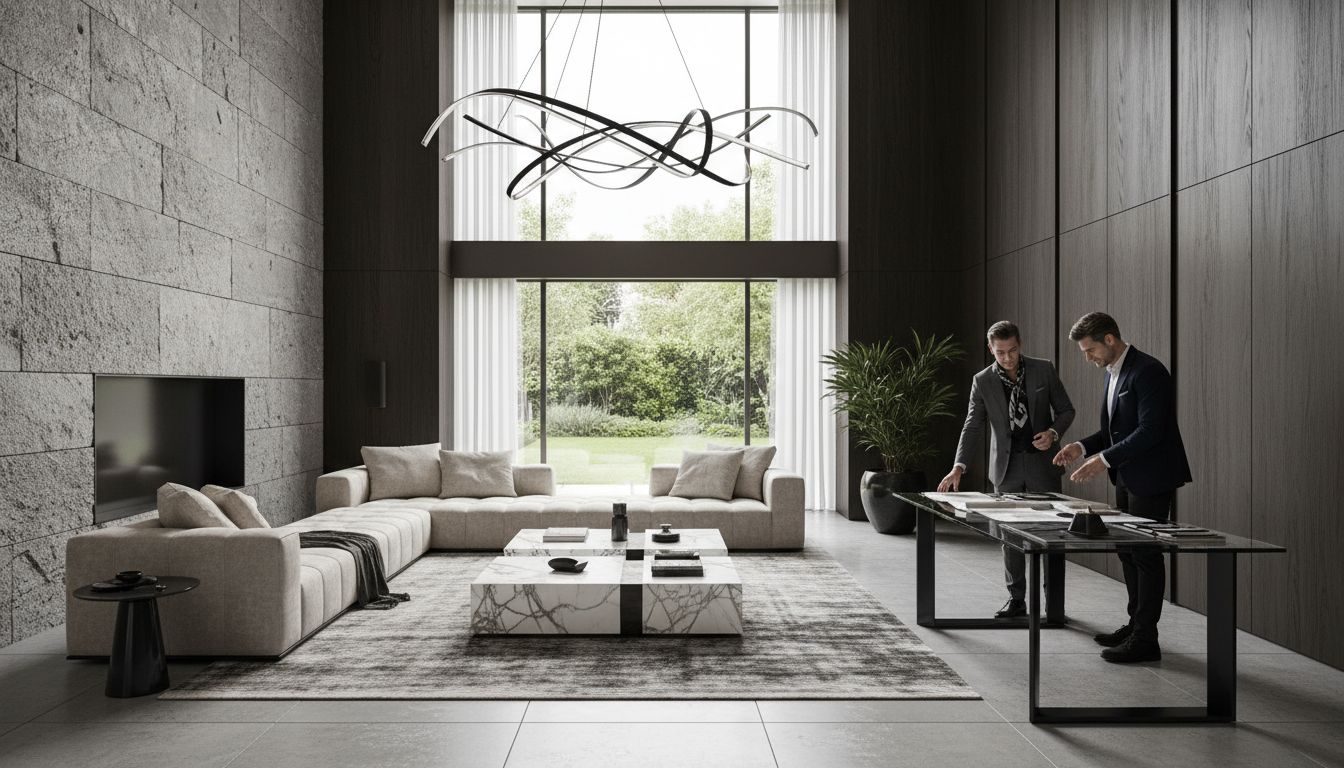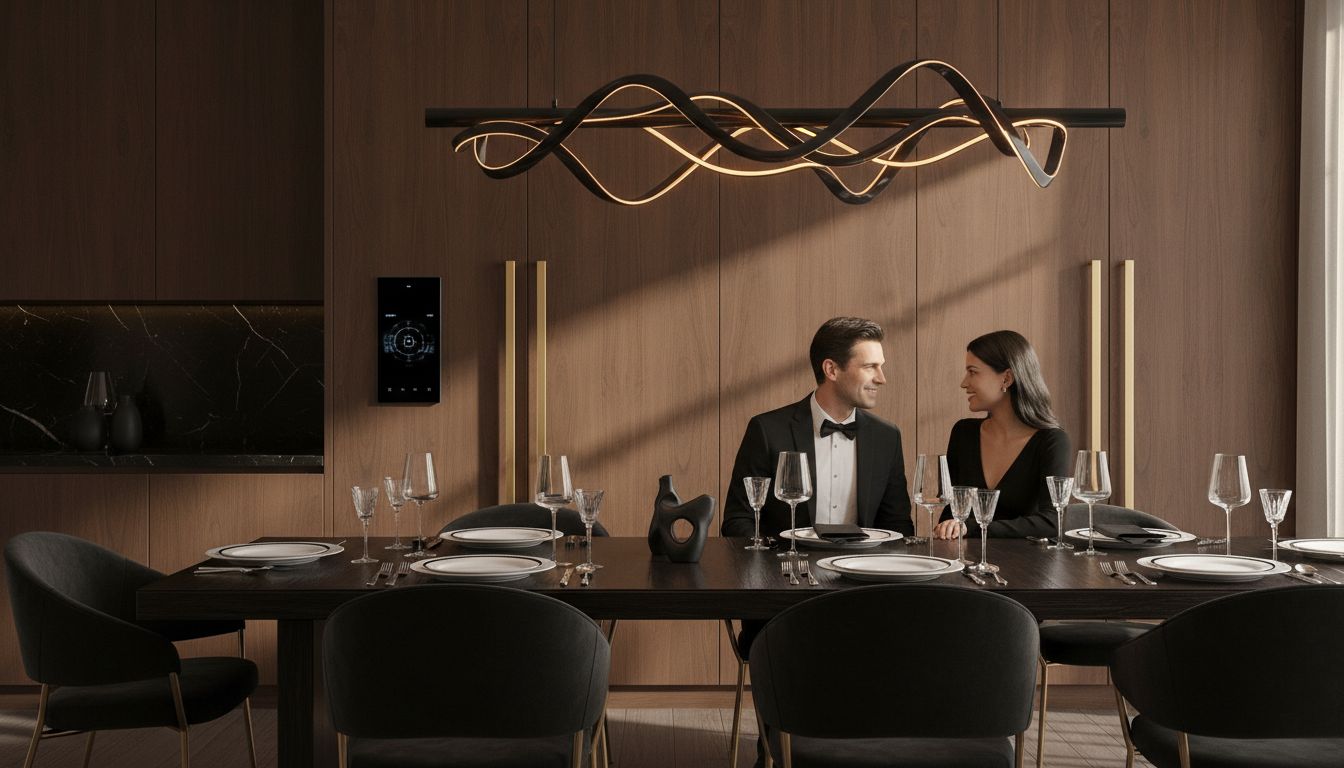What Is Luxury Interior Design? Complete Overview
- web46976
- 3 days ago
- 7 min read

Did you know that homes featuring luxury interior design can fetch up to 25 percent higher resale values compared to standard spaces? Elegance and comfort are not just for show—they change how you live and feel every day. Whether you appreciate rich materials or dream of a space that reflects your personality, understanding luxury design principles can help transform any room into a sophisticated sanctuary.
Table of Contents
Key Takeaways
Point | Details |
Essence of Luxury Design | Luxury interior design focuses on harmony, personal customization, and quality materials to create elegant, functional spaces. |
Distinguishing Features | Critical elements include premium materials, statement lighting, custom craftsmanship, and sophisticated technology integration. |
Popular Styles | Common luxury styles range from classic opulence to contemporary minimalism, each showcasing unique narratives of sophistication. |
Investment Value | Luxury design represents a significant investment resulting in timeless beauty and superior craftsmanship, offering exceptional long-term value. |
Defining Luxury Interior Design Principles
Luxury interior design transcends mere decoration. It is an art form that transforms living spaces into personalized sanctuaries of elegance and sophistication. According to homelovr, the core of luxury design emphasizes harmony, elegance, and style, creating environments that reflect individual taste and refined sensibility.
At its essence, luxury interior design hinges on several foundational principles. Teowin highlights the critical importance of using noble and natural materials like stone, solid wood, and high-end finishes. These materials aren’t just aesthetic choices but statements of quality and craftsmanship. The design approach prioritizes a delicate balance between visual appeal and functional comfort, ensuring spaces are not just beautiful but livable.
Key principles of luxury interior design include:
Impeccable Balance and Proportion: Carefully orchestrating furniture and decor to complement each other
Personalized Customization: Tailoring spaces specifically to individual client preferences
High-Quality Material Selection: Utilizing premium, natural materials with exceptional durability
Seamless Functionality: Designing spaces that are both aesthetically pleasing and practically efficient
Understanding these principles allows homeowners to elevate their living spaces from ordinary to extraordinary. While luxury design might seem intimidating, it’s ultimately about creating an environment that feels deeply personal and supremely comfortable. For more insights into design evolution, explore our The Evolution of Interior Design: A Century of Transformation article and discover how design philosophies have transformed over time.
Distinguishing Features and Signature Elements
Luxury interior design is distinguished by its extraordinary attention to detail and extraordinary quality. AIinterior reveals that signature elements are critical in creating spaces that transcend conventional design, focusing on materials, craftsmanship, and aesthetic sophistication.
The hallmarks of high-end interiors center around exceptional material selection and innovative design strategies. According to Urbmix, these distinguishing features include rare hardwoods, natural stones, and cutting-edge technology integration that elevates living spaces from mere functional environments to extraordinary personal sanctuaries.
Key distinguishing features of luxury interior design include:
Premium Material Selection: Utilizing rare and exotic materials like marble, onyx, and sustainably sourced hardwoods
Statement Lighting Design: Incorporating sculptural and artistic lighting fixtures that serve as focal points
Custom Craftsmanship: Emphasizing bespoke furniture and design elements created with meticulous precision
Sophisticated Technology Integration: Seamlessly blending smart home technologies with aesthetic design
These elements combine to create environments that are not just visually stunning but also deeply personalized and functionally advanced.

For those interested in exploring how design trends evolve, we recommend reading our The Top 9 Interior Design Trends for 2025 article to understand the future of luxury interior design.
Popular Luxury Styles and Inspirations
Luxury interior design is a rich tapestry of diverse aesthetic approaches that cater to individual preferences and unique sensibilities. Teowin reveals that luxury design styles span a fascinating spectrum from classic opulence to contemporary minimalism, each offering a distinctive narrative of elegance and personal expression.
The classical luxury style celebrates intricate details and timeless sophistication. Think rich, ornamental elements, elaborate moldings, deep color palettes, and sumptuous fabrics like velvet and silk. In contrast, contemporary luxury design embraces clean lines, open spaces, and a more restrained approach to material selection, prioritizing quality over quantity and focusing on innovative spatial configurations.
Popular luxury interior design styles include:
Here’s a summary of the popular luxury interior design styles:
Style | Key Characteristics | Signature Features |
Classic Luxury | Ornate details Rich textures Timeless look | Antique furniture Elaborate moldings |
Contemporary Luxury | Minimalist Clean lines Neutral palettes | Smart technology Open spaces |
Modern Luxury | Functional Cutting-edge materials | Sleek surfaces Bold statements |
Transitional Luxury | Blends old & new Balanced & timeless | Mix of classic and modern elements |
Classic Luxury: Characterized by ornate details, antique furniture, rich textures, and traditional architectural elements
Contemporary Luxury: Emphasizing minimalism, clean lines, neutral color schemes, and sophisticated technology integration
Modern Luxury: Blending functional design with high-end materials and cutting-edge aesthetic principles
Transitional Luxury: Combining traditional and modern elements for a balanced, timeless approach
For those intrigued by the evolving landscape of design aesthetics, our Unveiling the Interior Design Trends of 2024 article offers deeper insights into emerging luxury design perspectives and innovative style transformations.
The Process of Creating Luxury Spaces
Crafting luxury spaces is an intricate journey that transforms ordinary environments into extraordinary personal sanctuaries. Nilesh Sawant emphasizes that the process begins with an extraordinary attention to sumptuous materials and meticulous detailing, creating an atmosphere of refined elegance that speaks volumes about individual taste and sophistication.
The luxury interior design process involves a strategic, multi-layered approach that goes far beyond simple decoration. It starts with an in-depth consultation to understand the client’s lifestyle, personal aesthetic, and functional requirements. Designers then develop a comprehensive vision that balances visual drama with practical considerations, carefully selecting materials, color palettes, and design elements that create a harmonious and deeply personalized environment.
Key stages in creating luxury spaces include:
Initial Consultation: Deeply understanding client preferences, lifestyle, and design aspirations
Conceptual Design: Developing a comprehensive vision that integrates aesthetic and functional requirements
Material Selection: Curating premium materials that reflect quality and individual style
Custom Craftsmanship: Designing bespoke elements that transform spaces into unique personal statements
Precision Implementation: Executing the design with exceptional attention to detail and technical expertise
For homeowners seeking to understand the nuanced approach to transforming their living spaces, our article Why Hiring an Interior Designer Is Better Than Shopping Retail provides deeper insights into the value of professional design expertise.
Cost Factors and Value Considerations
Luxury interior design represents a significant investment that extends far beyond mere aesthetic enhancement. ASREB highlights that while premium design involves substantial financial commitment, it simultaneously delivers exceptional long-term value through timeless design principles and superior craftsmanship.
Understanding the cost landscape is crucial for homeowners contemplating luxury interior transformations. Interiors by Steven G emphasizes that the investment encompasses more than expensive materials - it’s about creating spaces that offer unparalleled comfort, functionality, and aesthetic sophistication. The true value emerges from meticulously selected materials, custom design elements, and expert implementation that elevate a space from ordinary to extraordinary.
Key cost factors in luxury interior design include:
Material Quality: Premium materials like rare marble, exotic woods, and handcrafted finishes
Custom Fabrication: Bespoke furniture, lighting fixtures, and architectural elements
Design Expertise: Professional consultation, innovative spatial planning, and detailed project management
Technology Integration: Smart home systems and cutting-edge technological amenities
Craftsmanship: Specialized skills and artisan-level execution
For those seeking to understand the strategic approach to design investments, our article How To Elevate Your Spaces Through Color offers additional insights into transformative design strategies that maximize both aesthetic and financial value.
Comparing Luxury and Standard Interior Design
Homelovr reveals a fundamental truth about interior design: luxury is not just about expense, but about transformation. While standard interior design focuses on basic functionality and surface-level aesthetics, luxury design elevates spaces into personalized sanctuaries that tell a profound story about individual style and sophisticated living.
The distinctions between luxury and standard interior design run far deeper than price points. ASREB emphasizes that luxury design transcends trends, prioritizing timeless elements that create lasting beauty and unparalleled comfort. Standard design often follows generic templates and mass-market trends, whereas luxury design crafts unique, meticulously curated environments that reflect individual narratives and exceptional craftsmanship.
Key differences between luxury and standard interior design include:
Material Quality: Luxury uses premium, rare materials; standard design relies on cost-effective, mass-produced options
Design Approach: Luxury offers personalized, bespoke solutions; standard design provides generic, one-size-fits-all strategies
Craftsmanship: Luxury emphasizes artisan-level execution; standard design prioritizes quick, economical implementation
Spatial Conception: Luxury reimagines entire living experiences; standard design focuses on basic room arrangements
Technological Integration: Luxury seamlessly blends cutting-edge technology; standard design offers basic functional solutions
For homeowners curious about design distinctions, our article Our First Blog Post! Designer vs. Decorator provides additional insights into professional design approaches.

Transform Your Home with True Luxury Interior Design
Luxury interior design is more than just choosing beautiful furniture or decorative accents. It is about creating a harmonious balance of impeccable materials, personalized craftsmanship, and seamless functionality that reflect your unique style and elevate your everyday living. If you have found yourself overwhelmed by the challenge of turning your home into a refined sanctuary that blends elegance with comfort, you are not alone. Achieving this level of sophistication requires professional guidance and a clear vision tailored to your needs.

Discover how Smith Interior Design can bring your luxury home aspirations to life with expert design solutions that focus on customization, exceptional detail, and timeless style. Visit Smith Interior Design to explore our portfolio of mountain retreats and modern remodels that showcase our commitment to excellence. Learn more about our process in Why Hiring an Interior Designer Is Better Than Shopping Retail and stay inspired by the latest innovations in The Top 9 Interior Design Trends for 2025. Take the first step to turn your home into a true statement of luxury and timeless elegance by reaching out today.
Frequently Asked Questions
What are the main principles of luxury interior design?
Luxury interior design is grounded in principles such as impeccable balance and proportion, personalized customization, high-quality material selection, and seamless functionality, aiming to create harmonious and elegant living spaces.
How does luxury interior design differ from standard interior design?
Luxury interior design focuses on bespoke solutions, premium materials, and artisan-level craftsmanship, whereas standard interior design often follows generic templates and uses mass-produced options, prioritizing basic functionality over personalized aesthetics.
What materials are commonly used in luxury interior design?
Common materials in luxury interior design include rare hardwoods, natural stones like marble and onyx, and high-quality finishes that showcase exceptional durability and craftsmanship, contributing to the overall opulence of the space.
What are some popular styles of luxury interior design?
Popular styles of luxury interior design include classic luxury, characterized by ornate details; contemporary luxury, which features minimalist designs; modern luxury, focusing on functional aesthetics; and transitional luxury, which blends traditional and modern elements for a timeless look.
Recommended



Comments